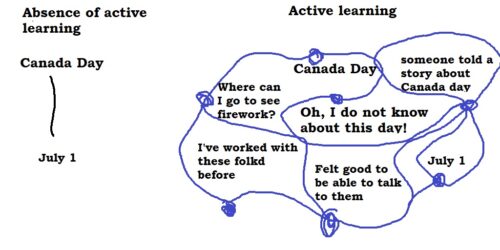Blogging with Medium in the Classroom
By Martha Terdik
Martha Terdik teaches in the Bachelor of Public Relations Program (BPR). After a successful 25-year career in corporate communications, Martha enjoys mentoring the next generation of professional communicators.
This faculty story is reproduced with permission. Follow Martha’s blog on Medium. Follow Martha on Twitter @marthaterdik.

I’ve discovered that teaching writing in the age of social media is a double-edged sword. On the one hand, it’s a constant challenge convincing students that texting isn’t the same as professional writing — LOL. On the other hand, incorporating online platforms makes for exciting and engaging class content. With this in mind, I developed a 15-week feature-writing course with the ultimate goal of having each student publish one blog on medium.com.
Not familiar with Medium? It’s an open blog platform that attracts writers of all descriptions — journalists, authors, experts as well as ordinary people with engaging interests and something to say. Topics are as diverse as the writers. Best of all, it’s a straightforward and intuitive platform. With a free account, anyone can write on Medium, track views, and read a limited number of articles. I purchased a subscription to access all of Medium’s features; however, this isn’t necessary for students. Anyone can access the basics of reading and posting stories.
Striving for 100 percent of students posting on Medium was an ambitious goal. So how did it go? Not perfectly, but surprisingly well. If you are interested in using Medium in your writing courses, here are five easy tips, and a couple of lessons learned, to help you get started.
It’s all about the content — make sure it’s interesting
I asked students to select an interest, hobby or social cause they were passionate about as the topic for all their writing assignments. Then they got to work, producing three feature stories reflecting different story angles and writing techniques. Talk about a great way to get to know your students! With stories ranging from the pandemic’s economic strain on the arts to the small changes we can all make to reduce plastic, their interests were eclectic and thought-provoking.
Include a peer review
This activity proved to be more valuable than I had expected. Students were asked to review each other’s assignments with one clear task: coach on specific writing techniques. I also added a firm rule: no editing for grammar allowed. Why this rule? I wanted students to focus on style and content holistically and constructively rather than defaulting to a more negative red-pen exercise.
Additionally, in a blended class of domestic and international students, coaching for readability vs. editing for accuracy creates a more level playing field for everyone.
Additional tip: After each feature, students submitted their work so that I could offer editing guidance prior to the peer review.
Make posting optional
How could I meet my 100 percent goal with an optional posting process? As well versed as my students are with social media, I suspected a few might be hesitant to publish on such a public platform. For this reason, I didn’t link evaluation marks with the actual posting process. While this was risky, I was delighted to discover that most students posted their blogs.
For many, it was the first time they had posted a blog, and they were thrilled to see their name published in such a public way. As one student said, “It was a rush to see my friends and family commenting on my piece and seeing them share it!”
Additional tip: While posting on Medium makes sense for students preparing for highly visible careers in public relations, it may not be an expectation for all courses. You can create a more private blogging experience for your students using Microsoft SharePoint or the discussion feature on eConestoga.
Engage SEO expertise before posting
If you’ve ever posted a blog and wondered why it wasn’t trending minutes later, you may benefit from learning more about search engine optimization (SEO).
If you’re not an SEO expert, find someone who is, and invite them to speak to your class. I have the good fortune to teach with Cheryl Williams who is doing a doctoral thesis in digital communications. Cheryl taught my students easy-to-follow SEO tips guaranteed to increase views on Medium and through links to other platforms.
Promote the activity as brand building
Remind your students that an online presence on Medium is a smart way to build a writing portfolio to showcase prospective employers. Encourage them to post different types of blogs that demonstrate their writing versatility. Posting on Medium is an excellent way for students to build their brand while still in school. Remind them to complete the bio section and post a professional photo.
What will I do differently the next time I teach this course?
- First, I’ll pay more attention to the topics they choose. Yes, the topics were varied and interesting. However, a few were just too far removed from students’ experiences to be practical. For example, a topic such as space exploration could prove challenging without a lot of additional research. I’ll encourage them to select interests, hobbies and social causes they are familiar with from personal experience.
- I will incorporate a second peer review. Let’s face it — receiving feedback from someone about the same age as your mother is never as relevant or as appreciated as receiving it from a peer. Students seemed to genuinely appreciate the guidance they received from peers of the same age and life experience. Even when our suggestions were the same, they heard it differently from their peers.
- Finally, I’ll highlight Web Content Accessibility Guidelines (WCAG) for posting on Medium. As guidelines are evolving and complex, I may invite an expert to speak on this topic.
It can be nerve-racking trying something new, especially when it involves such a public platform as Medium. My advice is to jump in and try it. While it may not go perfectly the first time, it’s guaranteed to add excitement and relevance to your writing courses.
I’m always interested in learning how others are incorporating platforms such as Medium in their courses. Are there any additional tips for teaching with Medium that you’d like to share?
Links to Students’ Blogs
Here is a sampling of my students’ blogs on Medium (shared with permission).



